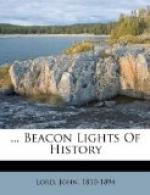During this seclusion of thirty years in the abbey of Bec, Anselm gave himself up to theological and philosophical studies, and became known both as a profound and original thinker and a powerful supporter of ecclesiastical authority. The scholastic age,—that is, the age of dialectics, when theology invoked the aid of philosophy to establish the truths of Christianity,—had not yet begun; but Anselm may be regarded as a pioneer, the precursor of Thomas Aquinas, since he was led into important theological controversies to establish the creed of Saint Augustine. It was not till several centuries after his death, however, that his remarkable originality of genius was fully appreciated. He anticipated Descartes in his argument to prove the existence of God. He is generally regarded as the profoundest intellect among the early schoolmen, and the most original that appeared in the Church after Saint Augustine. He was not a popular preacher like Saint Bernard, but he taught theology with marvellous lucidity to the monks who sought the genial quiet of his convent. As an abbot he was cheerful and humane, almost to light-heartedness, frank and kind to everybody,—an exception to most of the abbots of his day, who were either austere and rigid, or convivial and worldly. He was a man whom everybody loved and trusted, yet one not unmindful of his duties as the supreme ruler of his abbey, enforcing discipline, while favoring relaxation. No monk ever led a life of higher meditation than he; absorbed not in a dreamy and visionary piety, but in intelligent inquiries as to the grounds of religious belief. He was a true scholar of the Platonic and Angustinian school; not a dialectician like Albertus Magnus and Abelard, but a man who went beyond words to things, and seized on realities rather than forms; not given to disputatious and the sports of logical tournaments, but to solid inquiries after truth. The universities had not then arisen, but a hundred years later he would have been their ornament, like Thomas Aquinas and Bonaventura.
Like other Norman abbeys, the abbey of Bec had after the Conquest received lands in England, and it became one of the duties of the abbot to look after its temporal interests. Hence Anselm was obliged to make frequent visits to England, where his friendship with Lanfranc was renewed, and where he made the acquaintance of distinguished prelates and abbots and churchmen, among others of Eadmer, his future biographer. It seems that he also won the hearts of the English nobility by his gentleness and affability, so that they rendered to him uncommon attentions, not only as a great ecclesiastic who had no equal in learning, but as a man whom they could not help loving.




